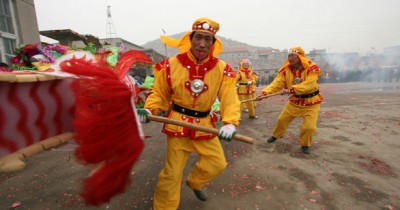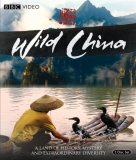| Reviews & Columns |
|
Reviews DVD TV on DVD Blu-ray 4K UHD International DVDs In Theaters Reviews by Studio Video Games Features Collector Series DVDs Easter Egg Database Interviews DVD Talk Radio Feature Articles Columns Anime Talk DVD Savant Horror DVDs The M.O.D. Squad Art House HD Talk Silent DVD
|
DVD Talk Forum |
|
|
| Resources |
|
DVD Price Search Customer Service #'s RCE Info Links |
|
Columns
|
|
|
Wild China
Taking advantage of improved Chinese-British relations in anticipation of the Beijing Olympics, this co-production had an unusually high level of support from the Chinese government, allowing the BBC's videographers access to parts of the country largely unexplored by western world nature documentarians. The big surprise and the best thing about Wild China is that it eschews the obvious and expected cliches in a Chinese nature documentary and travel show: giant pandas (of course), Beijing opera, the Great Wall, etc. Those kind of things are present in Wild China, but mostly the program introduces the viewer to extremely remote, staggeringly beautiful parts of the country with spectacular scenery unlike that found in any other part of the world.
At times the vistas are like something one imagines finding not merely on another continent but perhaps another planet, and the exotic, at times extremely colorful and bizarre plant and animal life add to this sense of, for a change, deserved Asian exoticism.
The viewer gets to see all kinds of wonderfully strange stuff: such creatures as the Chinese Giant Salamander and the Yunnan Snub-nosed monkey (see above), endangered species more like something you'd expect on the cover of 1930s sci-fi pulp magazine than in reality. Local men tie a white feather to the body of a distracted hornet, then follow the easily spotted feather-carrying hornet as it unwittingly betrays the location of its nest, where the two men then feast on its fattened larva. In another episode, fishermen using trained cormorants tie little wires around the birds' necks to prevent them from swallowing the day's catch, in a dying art practiced now by dwindling number of old men to dazzle tourists.
This relationship between man and nature is one of Wild China's central themes as is, predictably, the dire impact of global warming, over-development, and how the plundering of China's resources is impacting its wildlife. (China has another problem almost unique to that culture: the more endangered the animal, the more it's perceived as an exotic delicacy or cure-all medicine, hence the critically-endangered status of the China's freshwater turtles, its Giant Salamanders and many other animals shown.)
The series is divided into six hour-long episodes: "Heart of the Dragon," focusing on South China; "Shangri-La" (Yunnan Province); "Tibet"; "Beyond the Great Wall" (north of the Great Wall); "Land of the Panda" (Central China); and "Tides of Change," about its coastline, including its densely populated areas.
The series avoids the pretentious pseudo-mystical approach of Ganges, nor does it haphazardly race from one subject to the next, and it does a better job organizing the raw footage. The first episode, for instance, cleverly links the appearance of migratory swallows and their significance to rural rice farmers, and a good chunk of that episode intercuts the activities of the birds building their nests, etc., with the farmers working their strikingly beautiful terraced paddies. I would have preferred some interviews with local residents and scientific experts, but the sameness of the footage - when it's spectacular all the time it runs the risk of becoming dull - is broken up with other things. The second episode includes archival film footage of explorer-botanist Joseph Rock, "a real-life Indiana Jones." Photographs from Rock's 1920s expeditions, including some in full color, are really something. It's too bad a large collection of these images weren't included as an extra feature.
Video & Audio
Wild China is presented on two discs, one a BD 25 the other a BD 50. The 1.78:1 widescreen, 1080i transfer is like Ganges problematic. I don't honestly know the technical reason for this, but to explain it as best I can the image tends to look impressive when what's onscreen is relatively stationary or slow-moving: mountains and other landscapes, for instance, or Asian elephants slowly weaving through the thick brush. When there is a lot of motion, however - close-ups of farmers planting rice, gibbons racing from tree-to-tree - whatever is moving within the frame tends to become very blurry. I don't know this to be true, but it looks almost like in postproduction the show was run through a process to make it look less like high-definition video and more like film (i.e., when things move it's not like 30fps video but more closely resembles 24fps). If that was the goal it was not successful. Instead of looking like film it's simply hard on the eyes. This processing, if that's what it was, seems to have been done selectively, as individual shots don't seem to have this, usually time-lapse and other special camera shots. (Included is a terrific time-lapse montage of growing bamboo that's fascinating.)
Despite this major failing, there's still plenty of gorgeous scenery to look at, and certain colors, certain shots do look great, though given what Wild China could look like this release is nonetheless disappointing, especially considering that the original videography is excellent throughout.
The 5.1 Surround Sound audio is fairly strong, and the show has a good score (by Barnaby Taylor). Optional English and traditional Mandarin subtitles are included.
Extra Features
The only supplements, in 16:9 enhanced standard definition, is a half-hour behind-the-scenes documentary called Hunting Dragons. It's okay, but doesn't really add anything to the viewing experience unless you're interested in the workaday world of the nature documentarians.
Parting Thoughts
If you're interested in Asian nature and geography, or are thinking about visiting rural China, then Wild China has a lot to offer. For more general viewers however, and perhaps because of postproduction tweaking, the series is okay but underwhelming. Rent It.
This month Stuart Galbraith IV celebrates his 5th Anniversary at DVD Talk. You can read the very first review here.
|
| Popular Reviews |
| Sponsored Links |
|
|
| Sponsored Links |
|
|
| Release List | Reviews | Shop | Newsletter | Forum | DVD Giveaways | Blu-Ray | Advertise |
|
Copyright 2024 DVDTalk.com All Rights Reserved. Legal Info, Privacy Policy, Terms of Use,
Manage Preferences,
Your Privacy Choices | |||||||
















